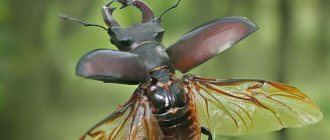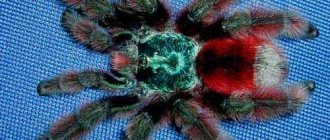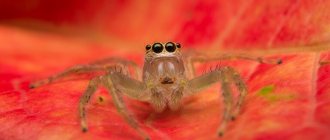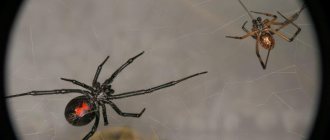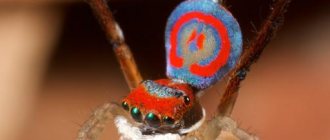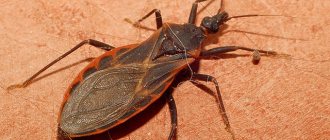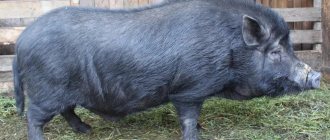Author: Eva Tushenkina
12 September 2022 17:42
Community: Animals
Tags: insects spiders tarantula goliath the largest the largest in the world
22729
12
1
Enable all animations
Spiders are not the prettiest insects and generally cause us dislike and even fear. But there is one type of spider that is much scarier than the rest - because this type of spider can be as big as your head. This is the Goliath tarantula, the largest spider in the world. But there is good news: most likely, such a spider will never attack you, because it is not aggressive.
They are usually harmless
0
Source:
But if nothing threatens them, goliath tarantulas are completely harmless. They just don't like it when someone bothers them and stands in their way. Although this spider is venomous, it rarely injects venom when biting unless it is hunting. If such a spider bites you and injects venom, you will feel pain and the bite site will swell. It will be like a wasp sting.
Tegenaria wall
This rare spider has a relatively small body - only 3-4 cm in length, but the leg span can exceed 14 cm. Its place of residence is abandoned buildings and caves. It is light brown in color with brown paws. Tegenaria is an excellent night hunter, briskly covering short distances. It feeds exclusively on small insects and can kill its relatives in the fight for prey. But for people it is completely harmless, although you can’t tell by its appearance.
Brazilian black and white tarantula
This aggressive and unpredictable spider grows up to 7-9 cm, with outstretched legs its length can reach 23 cm. From the name it is clear what color it is - black with white specks on the legs. Its habitat is Brazil, where it settles at the foot of trees or in rock crevices. This tarantula feeds mainly on crickets and other insects, as well as small lizards and mice. It does not pose a threat to people; its poison can only cause allergies.
Theraphose Blond
The largest spider, a member of the Theraphosa blondi species, was found in early 1965 in the forests of Venezuela. The span of its front legs is 28 centimeters. Listed in the Guinness Book of Records. In 2001, a representative of the spider family Sparassidae was discovered in the vicinity of the capital of Laos. According to notes and pictures in the scientist’s personal diary, the span of its paws was 30 centimeters, but this could not be confirmed, because no one had seen the spider itself.
It is worth noting that Theraphosa Blondie, found in Venezuela, is not such a revolution in the field of arachnology. All individuals of this species are large in themselves. The body of females on average reaches 90 mm in diameter, while in males it is 4-5 mm smaller. The span of the front legs of spiders ranges from 25-27 cm. They are covered with thick hairs of a red-brown hue.
You can meet Theraphosa blondi in the forests of Suriname, in the bushes of northern Brazil, in the vicinity of Paramaribo (Guyana) and in Venezuela. Spiders are not poisonous, but have large jaws that easily bite through human skin and inject a weak poison that causes temporary numbness of a limb or area of soft tissue.
Arabian cerbal (Cerbalus Aravaensis)
Leg span – up to 14 cm.
Arabian cerbal (Cerbalus Aravaensis)
Dehydration and sunstroke are not the only dangers that await travelers in the Arabian Desert on the border of Israel and Jordan. There you can find the largest huntsman spider in the Middle East. He builds a den in the sand and escapes the heat in the depths all day, and goes out hunting at night. Not very poisonous, as is believed, and not yet well studied. Like the spider Poecilotheria Rajaei, it was first discovered in 2009.
Lifestyle
The Goliath tarantula spider lives in humid, warm countries in swamps. This is the South of America, namely Brazil, Suriname, Guyana, Venezuela.
Theraphosa blond often settles in empty rodent burrows. Sometimes the spider digs out its own shelter.
The goliath tarantula does not like the sun. For normal existence, arachnids need darkness and high humidity. A temperature of about 25-30 °C is suitable for arthropods.
When the rainy season arrives, the goliath makes itself a shelter on an elevated plain. Theraphosa blond's home is a deep burrow, shrouded in cobwebs at the entrance.
As the name suggests, the goliath tarantula must eat birds. But this is a misconception; birds are not the spider’s favorite food. At the same time, Theraphosa blond does not intentionally hunt birds. But the spider can take advantage of the situation and eat the chick that has fallen out of the nest.
Goliath tarantula's hunting method:
- the spider waits for prey, hiding in a secluded place.
- When the prey is nearby, the goliath instantly attacks it and bites it to paralyze it with a neurotoxin.
The tarantula has another means of hunting, protecting itself or obtaining food. These are fangs, up to 2 cm long. The spider can easily pierce human skin with its poisonous teeth.
Like other tarantulas, tarantulas have poor eyesight. To hunt, arachnoids use vibrations coming from the ground. Sensing the trembling, the spiders determine the location of the victim and attack it.
Before attacking large prey, the goliath hisses loudly. Sound production is achieved through friction of the jaws.
When the female is ready to mate, she secretes special substances that attract males. The latter fight fiercely with each other to get the female. But the spider chooses her partner very carefully.
Females of the blond theraphosis are very caring towards their offspring. During fusion, the male supports the female's large chelicerae with his forepaws to protect himself. After mating, the males immediately run away to avoid being eaten by the spider.
After mating, females weave a small cocoon, necessary for future egg laying. At the same time, a spider can bear up to 200 eggs.
The period of egg development is 6-7 weeks. During this time, the female constantly looks after her offspring, taking the cocoon with her even when hunting.
During this period, the spider is especially aggressive. She may attack a large animal or person if she feels threatened. After hatching, the spiders do not leave their burrow until the first molt.
Tarantulas can molt and shed their skin. This is how they grow new legs to replace damaged limbs.
The molting process lasts 2-5 hours. The arachnoid increases fluid pressure in the body and sheds the dead paw. Then he pumps in new fluid to build up the limb.
Interestingly, residents of South America consider tarantulas a delicacy. For this reason, the Theraphosa blond population is constantly declining.
Nephila goldweaver
Nephil the golden weaver occupies tenth place in the ranking. The spider got its name thanks to its web. When the sun's rays fall on it, you might think that it is woven from golden threads. During the weaving process, the spider is able to change the color of the pigment of the threads, making it less noticeable to insects in dark or light areas. The strength of the web allows you to catch birds, bats and even snakes. The thread contains a chemical compound designed to repel ants.
Only female individuals weave a strong web with a golden hue. These spiders are prone to sexual dimorphism; females are almost 5 times larger than males in size. The limb span of females reaches 13 cm, and the total length of the male is only 2.5 cm.
Spider venom is toxic, but not fatal to humans. There may be redness and pain at the site of the bite.
It lives in warm regions of the planet - South America, Australia, Asia, Africa and Madagascar. Hides in forests with sandy soil.
Interesting: Fishermen use the nephil web instead of a fishing net, it is so strong.
Nutrition
As you probably already guessed, tarantulas are notorious predators, their food consists of numerous small insects and amphibians: caterpillars, mole crickets,
crickets, beetles, cockroaches, small frogs, etc. Tarantulas watch their prey from a hiding place and then quickly attack. Having attacked, they paralyze the prey with their poison, which subsequently turns its insides into a nutritious liquid, then the tarantula sucks it out like a “cocktail”.
The process of absorption of food by a tarantula can last several days, but in general they are not very voracious and can do without food for a long time, as long as they have access to water.
Lifestyle and habitat
Different types of such spiders take root in a wide variety of geographical areas and conditions. Among these representatives of the fauna, settlers of arid places and even deserts are known. There are species that prefer equatorial forests with their tropical humidity.
Arboreal tarantulas spend their days on bushes and trees, in their crowns among the branches. They weave webs and roll them into tubes. Others prefer solid ground and find shelter in this environment. There are quite a few species of spiders that dig holes for themselves that go deep underground. They cover their entrances with cobwebs.
Tarantulas can live in burrows (burrows) and trees
In addition, the habitat of these creatures largely depends on the stage of development of the individual. For example, as a larva, it spends its days in a hole, and when it grows up it begins to go out onto the ground (this happens in semi-arboreal and terrestrial species). That is, the behavior pattern of these spiders may change as they grow and mature.
Regarding the growth stages of such living beings. Newborn spiders that have just emerged from eggs are called nymphs. During this period of development, they usually do not need food.
Next, the nymphs, undergoing a couple of molts, during which rapid growth of the body occurs, turn into a larva (this is what spiders are called until they reach adulthood).
The hairs covering the body of such creatures are saturated with poison. For their owners themselves, this is a very useful acquisition they received from Mother Nature. Tarantulas use such fur shoots to protect nests by weaving them into webs.
Also, anticipating danger, they spread poisonous hair around themselves, thereby providing themselves with protection. If they enter the body through inhalation, even a person may experience painful symptoms: weakness, suffocation, burning - all these are signs of an allergic reaction.
Tarantula spiders are not particularly mobile. And if they break this rule, then only if there is a good reason. For example, female tarantulas, if they are well-fed, can sit in their shelters for several months. But even hungry individuals are motionless and patient. They are in their ambushes and stalk their prey.
Colombian purple tarantula
This rather rare spider lives in the tropical forests of Latin America. It received its name for the bright purple color of its legs, the span of which can reach 24 cm. The body of the spider is painted black or dark brown and is about 8-9 cm in length.
Its prey includes insects, toads, small rodents and birds. It can also eat a small spider as a snack. Although the purple tarantula is aggressive, it is not dangerous to people.
Video
And in conclusion, we invite you to watch an interesting documentary about tarantulas - “Tarantula - The Australian King of Spiders”.
Author: Pavel Chaika, editor-in-chief of Poznavaika magazine
When writing the article, I tried to make it as interesting, useful and high-quality as possible. I would be grateful for any feedback and constructive criticism in the form of comments on the article. You can also write your wish/question/suggestion to my email [email protected] or Facebook, with respect, the author.
Author page
This article is available in English -
Tarantula Spider.
Brazilian wandering spider
It is also called the runner, banana spider, or soldier. In length, its size is approximately 5-7 cm, and taking into account the paw span, it is about 17 cm. It is usually dark brown in color, but, depending on its habitat, it can have a red or even black tint. You are most likely to meet this spider in the tropical forests of Central and South America, but it is better not to do this, since it is considered one of the most poisonous representatives of its order.
The Brazilian wanderer hunts at night, catching up with its prey at high speed or overtaking it with powerful jumps. Its standard menu: insects, other spiders, lizards, frogs, small rodents and birds.
Phalanx
Other names for this giant: salpuga or camel spider. Its length is on average 7 cm, and its paw span reaches 15 cm. The usual habitat of salpugs is desert and steppe areas. This explains their discreet yellowish color.
Camel spiders are non-venomous, but they have very sharp chelicerae with teeth. Thanks to this, they can feed not only on insects, but also on small animals. They hunt mainly at night, waiting out the heat of the day in a cool hole.
Reproduction
The mating season for many species of tarantulas occurs in late summer. A sexually mature male weaves a web, then begins to rub his abdomen against it. As a result of this, he ejaculates seminal fluid, which ends up on the web. The male then plunges his pedipalps into it, which absorb it and become ready for fertilization.
And only then does the search for the female begin. Having found his “lady,” the male begins courtship, which includes performing a kind of courtship dance. If the female reciprocates the “gentleman’s feelings,” he plunges his pedipalps into her cloaca and fertilizes her. Then it is very advisable for the male to quickly leave his “lady” so as not to become dinner for her, as happens with
Praying mantis of some other insects.
Then the baton of prolongation of the genus passes to the female, she begins to weave a special cocoon where she lays her eggs; there are usually from 50 to 2000 eggs per clutch.
The eggs mature within 40-50 days, and small tarantulas hatch from them, which begin to grow rapidly, and by 2-3 years have already reached sexual maturity.
Keeping at home
Recently, some exotic pet lovers have been getting pet tarantulas. And why not, because they are quite easy to keep and can live in an aquarium or terrarium. At the bottom of the container it is necessary to pour a substrate consisting of a mixture of sand, clay and earth. Also, the tarantula terrarium should be equipped with an automatic drinker with fresh water and a shallow pool.
The optimal temperature for keeping these spiders should be 25-27 C. You can feed tarantulas with small pieces of fresh beef, as well as live cockroaches and frogs, if, of course, you can catch them. But fortunately, you don’t need to feed them often, so for an adult healthy tarantula it will be normal to eat once a week.
It is also important to remember that only one tarantula can be kept in a terrarium; if there are two of them, then as a result of constant skirmishes only one, the strongest, will survive.
